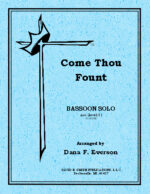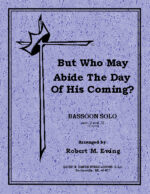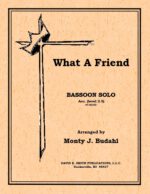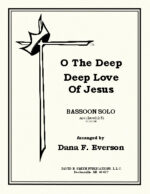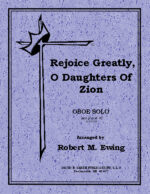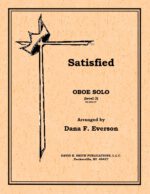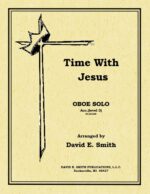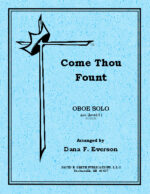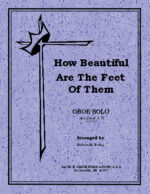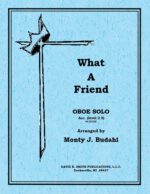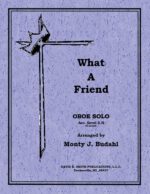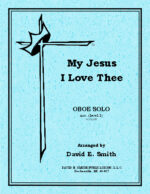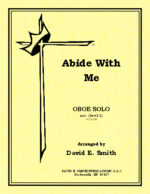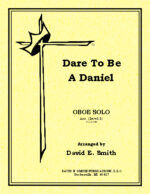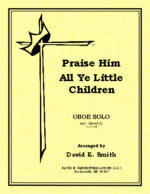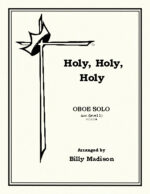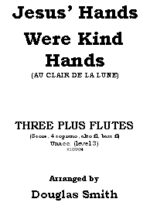-
Come Thou Fount
$4.50This bubbly rendition of “Come Thou Fount” is effervescent from beginning to end. It is filled with movement and excitement expressing intense joy throughout.
-
But Whom May Abide The Day…
$6.50Taken from the “Messiah”, this solo with piano is essentially a transcription of the original work. It features sufficient counterpoint between the various instruments.
-
What A Friend
$4.00A solo that begins with a brief introduction in the piano. The soloists then presents the tune in a straight-forward rendition. The second section presents the tune in the piano while the soloist overlays with a gentle obligato. The third section goes back to the melody briefly and then shifts back to the obligato and then settles into a final repose.
-
O The Deep Deep Love Of Jesus
$4.50This piece would serve well as a meditation. Beginning with a quiet Celtic lilt, the center section is stronger and bolder. After several bell effects, the piece returns to the mood of the beginning.
-
Rejoice Greatly Ye Daughters of Zion
$6.50Taken from the “Messiah”, this oboe solo with piano is essentially a transcription of the original work. The balance in the writing between the solo and the accompaniment gives way to the sensitivity of the text of this well-know aria..
-
My Faith Has Found A Resting Place
$5.50This oboe solo begins with a brief piano introduction and presents the tune in a gently embellished manner that creates interest. After a brief intermission the soloist presents the tune with even more melodic embellishment and ryhthmic activity. Another intermission coupled with a modulation where the piano now carries the tune while the soloist offsets it with a countermelody, The solo line now captures the tune and carries it to the end where it makes a final, restful statement.
-
Satisfied
$4.50This solo begins with a elegant little motif in the upper register of the piano and then moves downward to a simple accompanying figure. The solo enters in a gentle manner with minor modifications- very much in a restful manner. With an abrupt modulation the tune is modified once more in a different way. After two more modulations in the piano the soloist presents the tune with a more “arpeggiated” way and then settles into a final long note- as if “everything’s okay!”
-
What A Friend
$4.50This solo begins with a polite introduction and then is joined with the soloist in a gentle alteration of the tune in its entirety. A second verse is modulated upward with the tune with even more variation. After more modulations there is a brief cadenza and then a coda section based on the opening motif of the tune.
-
-
Come Thou Fount
$4.50This bubbly rendition of “Come Thou Fount” is effervescent from beginning to end. It is filled with movement and excitement expressing intense joy throughout.
-
How Beautiful Are The Feet
$4.00Taken from the “Messiah”, this solo with piano is essentially a transcription of the original work. The balance in the writing between the solo and the accompaniment gives way to the sensitivity of the text of this well-know aria..
-
What A Friend
$4.00A solo that begins with a brief introduction in the piano. The soloists then presents the tune in a straight-forward rendition. The second section presents the tune in the piano while the soloist overlays with a gentle obligato. The third section goes back to the melody briefly and then shifts back to the obligato and then settles into a final repose.
-
O The Deep Deep Love Of Jesus
$4.50This piece would serve well as a meditation. Beginning with a quiet Celtic lilt, the center section is stronger and bolder. After several bell effects, the piece returns to the mood of the beginning.
-
-
Tis So Sweet to Trust in Jesus
$3.50This solo with piano is structured in a quasi-rondo form. Thus making a great deal of variety in texture, style, and dynamic.It will make the young performer sound more advanced.
-
My Jesus I Love Thee
$3.50This solo with piano begins with a modified melodic statement. It enters into a second section with simple obligati and then returns to a beginning-like statement and ends with a simple coda.
-
Abide With Me
$3.50This solo piece with piano is presented in a straight-forward manner for the younger player with some altered pitches for interest.
-
Dare To Be A Daniel
$3.50This solo with piano begins with the strains of a lion’s roar. Next enters Daniel in a simple fashion followed by a statement in a triumphal march. The lions return-Daniel prevails.
-
Praise Him All Ye Little Children
$3.50This solo with piano begins with a bold march statement with an elongated rhythm of the melody. The middle section is more expressive while the final section imitates the beginning, with a solid statement of faith.
-
Holy, Holy, Holy
$3.50This solo with piano is straight forward in design, giving the young player the opportunity to display dynamic and stylistic variety.
-
I Want Jesus To Walk With Me
$11.00Three Plus Flutes for three soprano with opt. 4th/ob. with alto and bass. A beginning that is yearning in emotion and subtle shifts in harmonic and linear lines. A modulation to a higher tessitura in strong block chords gives a feeling of strength. The piece then settles back into the original key with a series of imitation of the various parts. The piece becomes more solemn as the pitch levels drop until settling into a final cadence.
-
The Master Hath Come
$11.00Three Plus Flutes for three soprano with opt. 4th/ob. with alto and bass & piccolo. An introduction using unrelated material leads the tune presented in voice two, supported by harmonies in the lower voices, then an obbligato-like motion added by the upper voice. A modulation upward makes room for a duet in the upper lines, later joined by the lower voices in a contrapuntal fashion. The final section becomes more vigorous and imitative until a solid, declamatory ending.
-
Jesus’ Hands Were Kind Hands
$11.00Three Plus Flutes for three soprano with opt. 4th/ob. with alto and bass & piccolo. The first phrase is stated in the top voice, then adding the second voice, further adding the third voice until all voices are in agreement. The next section moves in a rather jaunty motion going through various meter changes. The middle section is stated with the tune in the top voice with accompaniment figures presented in a syncopated manner. All this happening in a modulated key. Further modulation takes place with a motive stated in the second voice, followed the third, then first until it settles into a final statement of kindness.

